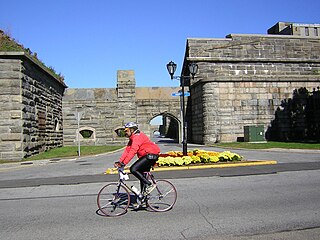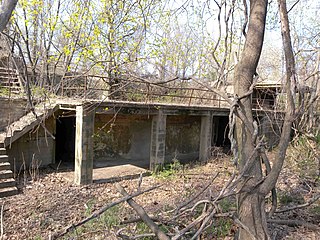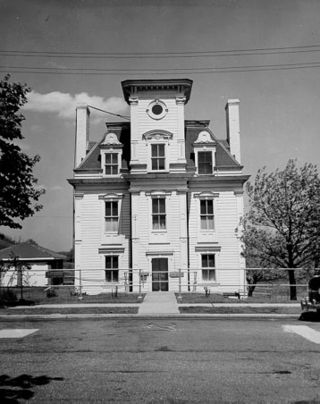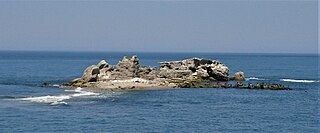
Fort Schuyler is a preserved 19th century fortification in the New York City borough of the Bronx. It houses a museum, the Stephen B. Luce Library, and the Marine Transportation Department and Administrative offices of the State University of New York Maritime College. It is considered one of the finest examples of early 19th century fortifications. The fort was named in honor of Major General Philip Schuyler of the Continental Army.

Fort William and Mary was a colonial fortification in Britain's worldwide system of defenses, defended by soldiers of the Province of New Hampshire who reported directly to the royal governor. The fort, originally known as "The Castle," was situated on the island of New Castle, New Hampshire, at the mouth of the Piscataqua River estuary. It was renamed Fort William and Mary circa 1692, after the accession of the monarchs William III and Mary II to the British throne. It was captured by Patriot forces, recaptured, and later abandoned by the British in the Revolutionary War. The fort was renamed Fort Constitution in 1808 following rebuilding. The fort was further rebuilt and expanded through 1899 and served actively through World War II.

Fort McClary is a former defensive fortification of the United States military located along the southern coast at Kittery Point, Maine at the mouth of the Piscataqua River. It was used throughout the 19th century to protect approaches to the harbor of Portsmouth, New Hampshire and the Portsmouth Naval Shipyard in Kittery. The property and its surviving structures are now owned and operated by the State of Maine as Fort McClary State Historic Site, including a blockhouse dating from 1844.

Fort Hamilton is a United States Army installation in the southwestern corner of the New York City borough of Brooklyn, surrounded by the communities of Bay Ridge and Dyker Heights. It is one of several posts that are part of the region which is headquartered by the Military District of Washington. Its mission is to provide the New York metropolitan area with military installation support for the Army National Guard and the United States Army Reserve. The original fort was completed in 1831, with major additions made in the 1870s and 1900s. However, all defenses except about half of the original fort have been demolished or buried.

Fort Wadsworth is a former United States military installation on Staten Island in New York City, situated on The Narrows which divide New York Bay into Upper and Lower halves, a natural point for defense of the Upper Bay and Manhattan beyond. Prior to closing in 1994 it claimed to be the longest continually garrisoned military installation in the United States. It comprises several fortifications, including Fort Tompkins and Battery Weed and was given its present name in 1865 to honor Brigadier General James Wadsworth, who had been killed in the Battle of the Wilderness during the Civil War. Fort Wadsworth is now part of the Staten Island Unit of Gateway National Recreation Area, maintained by the National Park Service.

Fort Totten is a former active United States Army installation in the New York City borough of Queens. It is located on the Willets Point peninsula on the north shore of Long Island. Fort Totten is at the head of Little Neck Bay, where the East River widens to become Long Island Sound. While the U.S. Army Reserve continues to maintain a presence at the fort, the property is now owned by the City of New York.

Fort Adams is a former United States Army post in Newport, Rhode Island that was established on July 4, 1799 as a First System coastal fortification, named for President John Adams who was in office at the time. Its first commander was Captain John Henry who was later instrumental in starting the War of 1812. The current Fort Adams was built 1824–57 under the Third System of coastal forts; it is part of Fort Adams State Park today.

Fort Hancock is a former United States Army fort at Sandy Hook in Middletown Township New Jersey. The coastal artillery base defended the Atlantic coast and the entrance to New York Harbor, with its first gun batteries operational in 1896. The fort served from then until 1950 as part of the Harbor Defenses of New York and predecessor organizations. Between 1874 and 1919, the adjacent US Army Sandy Hook Proving Ground was operated in conjunction with Fort Hancock. It is now part of Fort Hancock Memorial Park. It was preceded by the Fort at Sandy Hook, built 1857–1867 and demolished beginning in 1885.

Fort Mott, located in Pennsville, Salem County, New Jersey, United States, was part of the Harbor Defenses of the Delaware, a three-fort defense system designed for the Delaware River during the postbellum and Endicott program modernization periods following the American Civil War and in the 1890s. The other two forts in the system were Fort Delaware on Pea Patch Island and Fort DuPont in Delaware City, Delaware. It is now part of Fort Mott State Park.

Beavertail State Park is a public recreation area encompassing 153 acres (62 ha) at the southern end of Conanicut Island in Narragansett Bay, Rhode Island. The state park's main attraction is the active Beavertail Lighthouse, the current tower of which dates from 1856. During World War II, the park area was part of Fort Burnside, one of several coastal fortifications designed to protect Narragansett Bay. The park's scenic shoreline offers hiking, picnicking, and saltwater fishing.

Fort Tilden, also known as Fort Tilden Historic District, is a former United States Army installation on the coast in the New York City borough of Queens. Fort Tilden now forms part of the Gateway National Recreation Area, and is administered by the National Park Service.

Fort Tompkins Light was a lighthouse located on Staten Island, New York City, on the west side of the Narrows in New York Bay.

Gardiners Point Island is an island in Block Island Sound, New York, that was the former location of the Gardiners Island Lighthouse as well as Fort Tyler. Once a peninsula of Gardiners Island – permanently detached in 1888 by a storm – it had an area at least as large as 14 acres. Today it is part of the Long Island National Wildlife Refuge Complex, reduced, however, to a relative speck consisting of the foundations of the fort. It is locally referred to as "The Ruins".
A Patriot redoubt built in June 1776, located on Signal Hill at The Narrows on Staten Island. Site of an earlier 1663 blockhouse that stood until at least 1808, preceded by one built by Dutch settler David Pieterszen de Vries in 1636 and destroyed in the Peach Tree War of 1655. Taken by the British in July 1776 and by July 1779 a redoubt with gun platforms for 26 cannon was built. Two months later, six 24-pounders and four 18-pounders were recorded on hand. In 1782 the fort had five bastions and several barbette batteries. Evacuated by the British in 1783 at the end of the Revolution. In 1806 Flagstaff Fort was demolished and Fort Tompkins was built on the site, reportedly enclosing the 1663 blockhouse with red sandstone. That fort along with others grew into Fort Wadsworth. The site is now part of the Gateway National Recreation Area of the National Park Service.

Fort Tompkins is a fort on Staten Island in New York City, within what is now Fort Wadsworth at the Narrows. Fort Tompkins guarded the landward approaches to other forts in the area from 1808 through circa 1898. The current fort was built 1847-1861, and was operational as a fort until superseded by new defenses circa 1898. It is now part of the Gateway National Recreation Area. It is the last remaining of four forts in New York State named Fort Tompkins.

Fort Wadsworth Light is a 1903 lighthouse built atop Battery Weed on Staten Island in New York Harbor. The light illuminates the Narrows, the entrance to the harbor. It is located under the Verrazzano-Narrows Bridge. Fort Wadsworth Light was part of the transfer of Fort Wadsworth from the Navy to the National Park Service in March 1995 as part of Gateway National Recreation Area.

Highlands Air Force Station was a military installation in Middletown Township near the borough of Highlands, New Jersey. The station provided ground-controlled interception radar coverage as part of the Lashup Radar Network and the Semi-Automatic Ground Environment network, as well as providing radar coverage for the Highlands Army Air Defense Site. The site's 240 acres (97 ha) is now the Rocky Point section in Hartshorne Woods Park of the Monmouth County Parks System.

Fort Armistead was a United States Army coastal defense fort, active from 1901 to 1920, that defended Baltimore, Maryland.

The Harbor Defenses of New York was a United States Army Coast Artillery Corps harbor defense command. It coordinated the coast defenses of New York City from 1895 to 1950, beginning with the Endicott program, some of which were located in New Jersey. These included both coast artillery forts and underwater minefields. The command originated circa 1895 as an Artillery District(s) and became the Coast Defenses of Eastern New York and Coast Defenses of Southern New York in 1913. Circa 1915 the Coast Defenses of Sandy Hook separated from the latter command. In 1925 the commands were renamed as Harbor Defense Commands, and in 1935 the Harbor Defenses of Eastern New York was almost entirely disarmed, although possibly retaining the minefield capability. The New York and Sandy Hook commands and the Harbor Defenses of Long Island Sound were unified as the Harbor Defenses of New York on 9 May 1942.





















